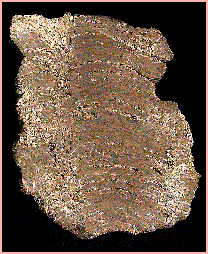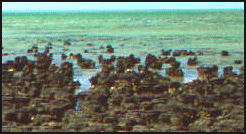
Oldest microbiota reported from Warrawoona Group of Australia at 3800 MY old. Prior to Schopf (1993) oldest microbiota was in the 3400-3500 MY old Onverwacht Group of South Africa and the Warrawoona Group of Australia.
Our understanding of the Archean is limited because of the rarity of fossiliferous rocks from this interval of geologic history. There are approximately 12 localities known that account for 1300 MY of time!
The assemblages are composed of:

Organisms are arranged in stromatolitic structures.
Stromatolite
Organosedimentary
structures produced by sediment trapping, binding and/or
precipitation as a result of the growth and metabolic activity of microorganisms, principally
cyanobacteria. Return to Early Evidence
for Terrestrialization
It is believed that these organisms were phototactic (behavior influenced by light) and photoautotrophs (produced their own food utilizing light as the energy source; photosynthetic).
These organisms are believed to have been anaerobic because the sediments in which they are preserved do not have oxidized irons (Banded Iron Formations).
Early Proterozoic microbiota are ecologically heterogenous and morphologically differentiated. Taphocoenoses occur in various marine (coastal) habitats. A diversification in stromatolitic structure is observed.
The organisms include:
1900 MY - Gunflint Chert biota.
1400 MY old assemblages are very diversified. Robust organic-walled microfossils, in addition to possibly eucaryotic organisms, are recovered. Cyst-forming planktonic algae had evolved, with reproductive (or resting) cysts preserved in shales. Obligate anaerobes have been identified.
In the belt Supergroup (western interior North America), carbonaceous impressions of :
Pyrite is found in association with these carbonaceous ribbons. These have been interpreted to be higher algal (brown, red, or green) metaphytes.
Late Proterozoic includes a diverse biota of procaryotes restricted to coastal settings in stromatolites and algal mats. Hypersaline lagoons are dominated by the procaryotic organisms. In other environments of deposition, eucaryotic cells are abundant, and these protists are heterotrophic. It is essential to understand the environment of deposition before interpreting diversification trends in the Proterozoic.
For example:
Both benthic and planktonic algae undergo a diversification at the Vendian-Cambrian boundary. This not only includes an increase in the numbers of different kinds, but also in the morphological complexity.

Stromatolites continue to form today (see photograph of Shark Bay, western Australia) as layers of calcium carbonate are precipitated over the growing mat of bacterial filaments in response to a depletion of carbon dioxide in the surrounding waters caused by photosynthesis. The minerals, along with grains of sediment precipitating from the water, are trapped within the sticky layer of mucilage that surrounds the bacterial colonies, which then continued to grow upwards through the sediment to form a new layer.